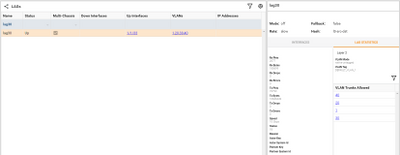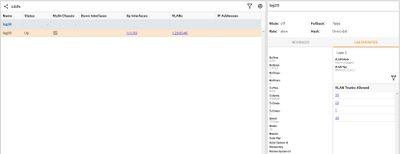The more I dive deeply into VSX Static LAG the more this configuration become interesting from the management standpoint...below my findings about VSX diagnostic done against my configured lag30 and its member interfaces 1/1/33.
ArubaOS-CX GUI reports the VSX (Multi-Chassis) Static LAG lag30 as Up (both interfaces are Up on both nodes):
ESXi host reported Up state for involved NICs' ports:

ESXi vSwitch2 used to test VSX Static LAG (lag30):
Properties
Network label DF Backend (1)
VLAN ID None (0)
Security
Promiscuous mode Reject
MAC address changes Accept
Forged transmits Accept
Traffic shaping
Average bandwidth --
Peak bandwidth --
Burst size --
Teaming and failover
Load balancing Route based on IP hash
INFO: In the IP hash load balancing policy all physical switch ports connected to the active uplinks must be in link aggregation mode.
INFO: IP hash load balancing should be set for all port groups using the same set of uplinks.
Network failure detection Link status only
Notify switches Yes
Failback Yes
Active adapters vmnic1, vmnic7
Standby adapters --
Unused adapters --
And visually:
Aruba 8320 VSX Primary VSX Static LAG (lag30) status:


Aruba 8320 VSX Secondary VSX Static LAG (lag30) status:

Now the CLI part:
=== Aruba 8320 Node 1 (Primary) VSX Static LAG configuration ===
interface lag 30 multi-chassis static
vsx-sync vlans
description 8320-1-VSX-LAG-Static-lag30-ESXi01
no shutdown
no routing
vlan trunk native 1
vlan trunk allowed 1,20,30,40
loop-protect
loop-protect vlan 1,20,30,40
interface 1/1/33
description Leg_to_s1p2_ESXi01_vmnic1_vSwitch2
no shutdown
mtu 9198
flow-control rx
lag 30
=== Aruba 8320 Node 2 (Secondary) VSX Static LAG configuration ===
interface lag 30 multi-chassis static
vsx-sync vlans
description 8320-2-VSX-LAG-Static-lag30-ESXi01
no shutdown
no routing
vlan trunk native 1
vlan trunk allowed 1,20,30,40
loop-protect
loop-protect vlan 1,20,30,40
interface 1/1/33
description Leg_to_s3p2_ESXi01_vmnic7_vSwitch2
no shutdown
mtu 9198
flow-control rx
lag 30
=== Aruba 8320 VSX Static LAG (lag30) diagnostic on Primary and Secondary ===
Aruba-8320-1# show lacp aggregates
Aggregate name : lag30 (multi-chassis)
Interfaces : 1/1/33
Peer interfaces : 1/1/33
Heartbeat rate : N/A
Hash : l3-src-dst
Aggregate mode : Off
Aruba-8320-1# show lacp aggregates vsx-peer
Aggregate name : lag30 (multi-chassis)
Interfaces : 1/1/33
Peer interfaces : 1/1/33
Heartbeat rate : N/A
Hash : l3-src-dst
Aggregate mode : Off
Aruba-8320-1# show vsx lacp aggregates lag30
Local-peer Remote-peer
-------------------------------------------------------------------------------
Aggregate name : lag30 (multi-chassis) lag30 (multi-chassis)
Interfaces : 1/1/33 1/1/33
Peer interfaces : 1/1/33 1/1/33
Heartbeat rate : N/A N/A
Hash : l3-src-dst l3-src-dst
Aggregate mode : Off Off
Aruba-8320-2# show vsx lacp aggregates lag30
Local-peer Remote-peer
-------------------------------------------------------------------------------
Aggregate name : lag30 (multi-chassis) lag30 (multi-chassis)
Interfaces : 1/1/33 1/1/33
Peer interfaces : 1/1/33 1/1/33
Heartbeat rate : N/A N/A
Hash : l3-src-dst l3-src-dst
Aggregate mode : Off Off
Aruba-8320-1# show lacp interfaces
State abbreviations :
A - Active P - Passive F - Aggregable I - Individual
S - Short-timeout L - Long-timeout N - InSync O - OutofSync
C - Collecting D - Distributing
X - State m/c expired E - Default neighbor state
Actor details of all interfaces:
------------------------------------------------------------------------------
Intf Aggr Port Port State System-ID System Aggr Forwarding
Name Id Pri Pri Key State
------------------------------------------------------------------------------
1/1/33 lag30(mc) up
Partner details of all interfaces:
------------------------------------------------------------------------------
Intf Aggr Port Port State System-ID System Aggr
Name Id Pri Pri Key
------------------------------------------------------------------------------
1/1/33 lag30(mc)
Aruba-8320-1# show lacp interfaces vsx-peer
State abbreviations :
A - Active P - Passive F - Aggregable I - Individual
S - Short-timeout L - Long-timeout N - InSync O - OutofSync
C - Collecting D - Distributing
X - State m/c expired E - Default neighbor state
Actor details of all interfaces:
------------------------------------------------------------------------------
Intf Aggr Port Port State System-ID System Aggr Forwarding
Name Id Pri Pri Key State
------------------------------------------------------------------------------
1/1/33 lag30(mc) up
Partner details of all interfaces:
------------------------------------------------------------------------------
Intf Aggr Port Port State System-ID System Aggr
Name Id Pri Pri Key
------------------------------------------------------------------------------
1/1/33 lag30(mc) And configuration related events generated during lag30 setup yesterday (Errors on VSX Secondary should be probably related to the fact I was saving VSX Primary before lag30 was configured on VSX Secondary):
=== Aruba 8320 Node 1 (Primary) VSX Static LAG events related to 1/1/33 and lag30 configuration ===
2019-09-24:16:43:17.115485|hpe-rdiscd|3910|LOG_INFO|AMM|-|Interface: 1/1/33 is deleted from router discovery
2019-09-24:16:47:17.218517|hpe-rdiscd|3910|LOG_INFO|AMM|-|Interface: 1/1/34 is deleted from router discovery
2019-09-24:17:03:11.653192|hpe-config|6801|LOG_INFO|AMM|-|Copying configs from: running-config to: startup-config
2019-09-24:17:10:02.902801|hpe-config|6801|LOG_INFO|AMM|-|Copying configs from: running-config to: startup-config
2019-09-24:17:16:59.661158|lacpd|1303|LOG_INFO|AMM|-|Interface 1/1/33 added to LAG 30. Existing configuration on interface 1/1/33 will be removed.
2019-09-24:17:16:59.696098|ops-switchd|4803|LOG_INFO|AMM|-|All dynamic MAC addresses on port 1/1/33 were flushed
2019-09-24:17:16:59.699173|ops-switchd|1401|LOG_DEBUG|AMM|-|Trunk set succeeds unit 0 lag_id 4
2019-09-24:17:16:59.699216|ops-switchd|1301|LOG_INFO|AMM|-|Dynamic LAG lag30 created
2019-09-24:17:16:59.699255|ops-switchd|1409|LOG_INFO|AMM|-|LAG lag30, set to load balance mode to l3-src-dst-hash
2019-09-24:17:16:59.701674|ops-switchd|1404|LOG_DEBUG|AMM|-|Trunk member add port succeeds on unit 0 hw_port 33 tid 4
2019-09-24:17:17:35.273114|hpe-vsxd|7014|LOG_INFO|AMM|-|VSX 30 state local down, remote down
2019-09-24:17:17:44.802017|hpe-config|6801|LOG_INFO|AMM|-|Copying configs from: running-config to: startup-config
2019-09-24:17:29:02.232570|pmd|3804|LOG_INFO|AMM|-|Transceiver hot-swap insert for interface 1/1/33
2019-09-24:17:33:40.949961|hpe-vsxd|7014|LOG_INFO|AMM|-|VSX 30 state local down, remote down
2019-09-24:17:33:41.026283|hpe-vsxd|7012|LOG_INFO|AMM|-|VSX 30 state local down, remote up
2019-09-24:17:34:25.107870|lldpd|110|LOG_INFO|AMM|-|Configured LLDP reinit-delay to 2
2019-09-24:17:34:25.124641|intfd|403|LOG_INFO|AMM|-|Link status for interface 1/1/33 is up
2019-09-24:17:34:25.152520|hpe-vsxd|7013|LOG_INFO|AMM|-|VSX 30 state local up, remote up
2019-09-24:17:34:25.156592|hpe-vsxd|7013|LOG_INFO|AMM|-|VSX 30 state local up, remote up
2019-09-24:17:34:33.320050|lldpd|104|LOG_INFO|AMM|-|LLDP neighbor f8:f2:1e:59:e7:91 added on 1/1/33
=== Aruba 8320 Node 2 (Secondary) VSX Static LAG events related to 1/1/33 and lag30 configuration ===
2019-09-24:16:50:15.097019|hpe-rdiscd|3910|LOG_INFO|AMM|-|Interface: 1/1/33 is deleted from router discovery
2019-09-24:17:03:00.228386|hpe-config|6801|LOG_INFO|AMM|-|Copying configs from: running-config to: startup-config
2019-09-24:17:03:16.174430|vsx-syncd|7603|LOG_INFO|AMM|-|Configuration-persistence : configuration saved to startup-configuration on primary VSX device.
2019-09-24:17:03:16.580494|hpe-config|6801|LOG_INFO|AMM|-|Copying configs from: running-config to: startup-config
2019-09-24:17:03:23.817133|vsx-syncd|7603|LOG_INFO|AMM|-|Configuration-persistence : configuration saved to startup-configuration on secondary VSX device.
2019-09-24:17:07:00.282175|hpe-rdiscd|3910|LOG_INFO|AMM|-|Interface: 1/1/34 is deleted from router discovery
2019-09-24:17:09:52.080474|hpe-config|6801|LOG_INFO|AMM|-|Copying configs from: running-config to: startup-config
2019-09-24:17:10:07.285763|vsx-syncd|7603|LOG_INFO|AMM|-|Configuration-persistence : configuration saved to startup-configuration on primary VSX device.
2019-09-24:17:10:07.683633|hpe-config|6801|LOG_INFO|AMM|-|Copying configs from: running-config to: startup-config
2019-09-24:17:10:14.894096|vsx-syncd|7603|LOG_INFO|AMM|-|Configuration-persistence : configuration saved to startup-configuration on secondary VSX device.
2019-09-24:17:16:39.026350|vsx-syncd|7602|LOG_INFO|AMM|-|Configuration sync update : Missing Reference Error: Could not find Port lag30 on secondary VSX database.
2019-09-24:17:16:39.218306|vsx-syncd|7601|LOG_ERR|AMM|-|Configuration sync error : Missing reference in database while syncing configuration. Use "show running-config vsx-sync peer-diff" to help identify the missing reference.
2019-09-24:17:16:43.328284|vsx-syncd|7602|LOG_INFO|AMM|-|Configuration sync update : Missing Reference Error: Could not find Port lag30 on secondary VSX database.
2019-09-24:17:16:43.527611|vsx-syncd|7601|LOG_ERR|AMM|-|Configuration sync error : Missing reference in database while syncing configuration. Use "show running-config vsx-sync peer-diff" to help identify the missing reference.
2019-09-24:17:16:47.196342|vsx-syncd|7602|LOG_INFO|AMM|-|Configuration sync update : Missing Reference Error: Could not find Port lag30 on secondary VSX database.
2019-09-24:17:16:47.507171|vsx-syncd|7601|LOG_ERR|AMM|-|Configuration sync error : Missing reference in database while syncing configuration. Use "show running-config vsx-sync peer-diff" to help identify the missing reference.
2019-09-24:17:17:03.590207|vsx-syncd|7601|LOG_ERR|AMM|-|Configuration sync error : Missing reference in database while syncing configuration. Use "show running-config vsx-sync peer-diff" to help identify the missing reference.
2019-09-24:17:17:19.850505|hpe-vsxd|7014|LOG_INFO|AMM|-|VSX 30 state local down, remote down
2019-09-24:17:17:22.585726|vsx-syncd|7602|LOG_INFO|AMM|-|Configuration sync update : VSX configuration-sync updated database
2019-09-24:17:17:35.231058|lacpd|1303|LOG_INFO|AMM|-|Interface 1/1/33 added to LAG 30. Existing configuration on interface 1/1/33 will be removed.
2019-09-24:17:17:35.327042|ops-switchd|4803|LOG_INFO|AMM|-|All dynamic MAC addresses on port 1/1/33 were flushed
2019-09-24:17:17:35.332017|ops-switchd|1401|LOG_DEBUG|AMM|-|Trunk set succeeds unit 0 lag_id 6
2019-09-24:17:17:35.332083|ops-switchd|1301|LOG_INFO|AMM|-|Dynamic LAG lag30 created
2019-09-24:17:17:35.332150|ops-switchd|1409|LOG_INFO|AMM|-|LAG lag30, set to load balance mode to l3-src-dst-hash
2019-09-24:17:17:35.335095|ops-switchd|1404|LOG_DEBUG|AMM|-|Trunk member add port succeeds on unit 0 hw_port 33 tid 6
2019-09-24:17:17:40.764550|hpe-config|6801|LOG_INFO|AMM|-|Copying configs from: running-config to: startup-config
2019-09-24:17:17:56.876722|vsx-syncd|7603|LOG_INFO|AMM|-|Configuration-persistence : configuration saved to startup-configuration on secondary VSX device.
2019-09-24:17:29:22.147653|pmd|3804|LOG_INFO|AMM|-|Transceiver hot-swap insert for interface 1/1/33
2019-09-24:17:33:40.963502|lldpd|110|LOG_INFO|AMM|-|Configured LLDP reinit-delay to 2
2019-09-24:17:33:40.979534|intfd|403|LOG_INFO|AMM|-|Link status for interface 1/1/33 is up
2019-09-24:17:33:41.020537|hpe-vsxd|7011|LOG_INFO|AMM|-|VSX 30 state local up, remote down
2019-09-24:17:33:41.029885|hpe-vsxd|7011|LOG_INFO|AMM|-|VSX 30 state local up, remote down
2019-09-24:17:33:49.295089|lldpd|104|LOG_INFO|AMM|-|LLDP neighbor e4:43:4b:7a:f9:12 added on 1/1/33
2019-09-24:17:34:25.163042|hpe-vsxd|7013|LOG_INFO|AMM|-|VSX 30 state local up, remote up
So...in the end...the setup I've done looks correct from a pure configuration standpoint, at least looking at what Aruba nodes' GUIs report...BUT the usual command show lacp interface multi-chassis apparently fails to report lag30(mc) status correctly.
At this point my main question is:
Provided that one want to deploy a VSX Static LAG because no LAG LACP is supported by downlinked peer (here the ESXi)...is there on ArubaOS-CX 10.2/10.3 an equivalent to the well known ArubaOS-Switch's show trunks in order to diagnose the VSX Static LAG status since the show lacp interface multi-chassis (exactly because is heavily LACP biased?) seems to refuse to report anything about a Multi-Chassis Static LAG? or...Am I missing some other documented alternative about how to diagnose a VSX Static LAG? forgot to specify I'm on ArubaOS-CX 10.02.0031...not yet on 10.03.